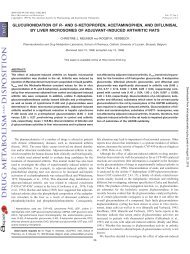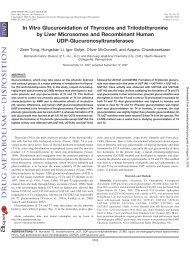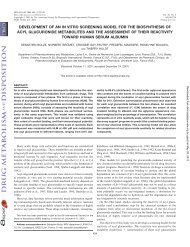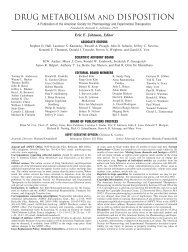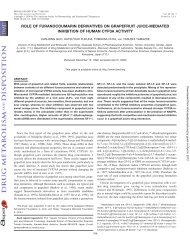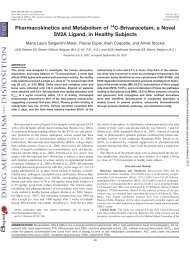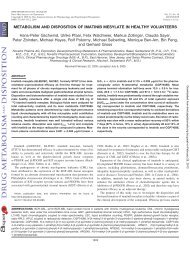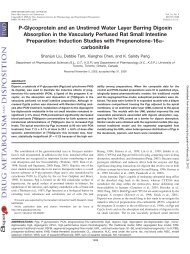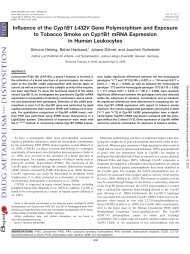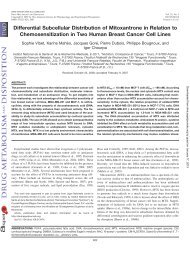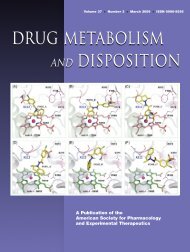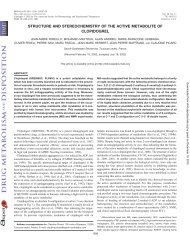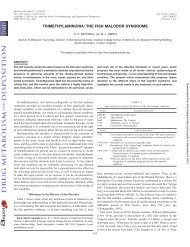pharmacokinetics and plasma protein binding of tamsulosin - Drug ...
pharmacokinetics and plasma protein binding of tamsulosin - Drug ...
pharmacokinetics and plasma protein binding of tamsulosin - Drug ...
You also want an ePaper? Increase the reach of your titles
YUMPU automatically turns print PDFs into web optimized ePapers that Google loves.
FIG. 1.Chemical structure <strong>of</strong> <strong>tamsulosin</strong> (a) <strong>and</strong> amosulalol (b).<br />
(ca. 5 ml/time point) was collected from the forelimb vein predosing, <strong>and</strong> at<br />
7.5, 15, <strong>and</strong> 30 min <strong>and</strong> 1, 2, 3, 4, 6, 8, <strong>and</strong> 10 hr after dosing. The same dogs<br />
were used in the iv <strong>and</strong> oral dosing studies except for the 3-mg/kg oral dosing<br />
study, following a washout period <strong>of</strong> at least 1 week. The 3-mg/kg oral dosing<br />
study was conducted on five different dogs. Plasma was separated by centrifugation<br />
at 1000g for 15 min <strong>and</strong> stored at 20°C until analysis. Dose levels in<br />
these animal studies were selected to measure the <strong>plasma</strong> <strong>tamsulosin</strong> concentrations<br />
with sufficient sensitivity.<br />
Clinical Study. Eight Japanese healthy male volunteers (20–24 yr old,<br />
52–74 kg, 161.2–181 cm) were enrolled in the study. Subjects were divided<br />
into groups A <strong>and</strong> B with four subjects in each group. Group A was orally<br />
dosed with <strong>tamsulosin</strong> in a capsule form (lactose-triturated powder) at a dose<br />
<strong>of</strong> 0.2 mg <strong>and</strong> group B at doses <strong>of</strong> 0.05 <strong>and</strong> 0.1 mg. Blood was collected from<br />
the antecubital vein using a heparinized syringe predosing, <strong>and</strong> at 0.5, 1, 2, 3,<br />
4, 6, 8, 12, 15, <strong>and</strong> 24 hr after dosing. After centrifugation, <strong>plasma</strong> was<br />
separated <strong>and</strong> stored at 20°C until analysis.<br />
Sample Analysis. An aliquot <strong>of</strong> <strong>plasma</strong> (1.5 ml) was buffered with 1 ml <strong>of</strong><br />
saturated sodium bicarbonate solution <strong>and</strong> extracted with 5 ml <strong>of</strong> ethyl acetate<br />
after addition <strong>of</strong> 100 l <strong>of</strong> internal st<strong>and</strong>ard aqueous solution (250 ng <strong>of</strong><br />
amosulalol). The extract was removed <strong>and</strong> then 2.5 ml <strong>of</strong> 0.4N HCl was added.<br />
The mixture was shaken, centrifuged, <strong>and</strong> the organic layer was discarded. The<br />
water layer was buffered with 2 ml <strong>of</strong> saturated sodium bicarbonate solution<br />
<strong>and</strong> extracted again with 5 ml <strong>of</strong> ethyl acetate. The extract was removed <strong>and</strong><br />
evaporated to dryness under reduced pressure. The residue was dissolved in 50<br />
l <strong>of</strong> 0.1 M NaHCO 3, <strong>and</strong> 500 g <strong>of</strong> dansylchloride dissolved in acetone (100<br />
l) was added. Reaction was performed for 90 min at 35°C. After addition <strong>of</strong><br />
5 ml <strong>of</strong> distilled water, the reaction mixture was extracted with 5 ml <strong>of</strong> diethyl<br />
ether. The extract was removed <strong>and</strong> evaporated to dryness in a water bath at<br />
45°C. The residue was reconstituted in 60 l <strong>of</strong> the mobile phase (benzene/<br />
methanol 100:1 v/v), <strong>and</strong> a small aliquot (20–50 l) <strong>of</strong> the sample was injected<br />
onto the HPLC system. Tamsulosin <strong>and</strong> amosulalol, which were dansylated,<br />
were detected after elution from a normal phase column (Nucleosil SI100-5,<br />
250 mm 4 mm i.d., Chemco, Osaka, Japan) by use <strong>of</strong> a fluorescence detector<br />
(RF-535, Shimadzu, Kyoto, Japan) with excitation at 352 nm <strong>and</strong> emission at<br />
500 nm. The low limit <strong>of</strong> quantitation (LLOQ) 1 was 0.5 ng/ml for human<br />
<strong>plasma</strong> <strong>and</strong> 1.0 ng/ml for rat <strong>and</strong> dog <strong>plasma</strong>. The intra <strong>and</strong> interday precision<br />
expressed as coefficient <strong>of</strong> variance for LLOQ <strong>and</strong> each quality control (QC)<br />
concentration (3, 250, <strong>and</strong> 400 ng/ml for rats <strong>and</strong> dogs <strong>and</strong> 1.5, 40, <strong>and</strong> 60<br />
ng/ml for humans) was within 13.41% for rat <strong>plasma</strong>, within 8.7% for dog<br />
<strong>plasma</strong>, <strong>and</strong> within 13.88% for human <strong>plasma</strong>. The intra <strong>and</strong> interday accuracy<br />
expressed as relative error for the LLOQ <strong>and</strong> QC concentration was within<br />
13.35% for rat <strong>plasma</strong>, within 7.36% for dog <strong>plasma</strong>, <strong>and</strong> within 13.83% for<br />
human <strong>plasma</strong>. Tamsulosin could be quantified over the range 1–500 ng/ml in<br />
rat <strong>and</strong> dog <strong>plasma</strong> <strong>and</strong> 0.5–80 ng/ml in human <strong>plasma</strong>.<br />
Determination <strong>of</strong> the Ratio <strong>of</strong> Blood to Plasma Concentrations (R B).<br />
Heparinized blood <strong>of</strong> rats, dogs, <strong>and</strong> humans was used. To 2.95-ml aliquots <strong>of</strong><br />
blood, 0.05-ml aliquots <strong>of</strong> phosphate buffered isotonic solution (pH 7.4)<br />
containing 14 C-<strong>tamsulosin</strong> were added to make concentrations <strong>of</strong> 50 ng/ml in<br />
rat <strong>and</strong> dog blood <strong>and</strong> 200 ng/ml in human blood (N 3 for each species).<br />
After incubation for 30 min at 37°C, a 0.05-ml aliquot was taken from each<br />
PHARMACOKINETICS OF TAMSULOSIN<br />
blood sample to measure the blood concentration, <strong>and</strong> the remaining sample<br />
was centrifuged for 15 min at 1000g. After centrifugation, a 0.05-ml aliquot <strong>of</strong><br />
<strong>plasma</strong> was taken to measure the <strong>plasma</strong> concentration. This 0.05-ml aliquot <strong>of</strong><br />
<strong>plasma</strong> was diluted to 1 ml with distilled water, <strong>and</strong> 10 ml <strong>of</strong> liquid scintillator<br />
(Aquasol-2, New Engl<strong>and</strong> Nuclear, Boston, MA) was added. The 0.05-ml<br />
aliquot <strong>of</strong> blood was added to the mixture <strong>of</strong> 0.5 ml <strong>of</strong> tissue solubilizer<br />
(Solene 350, Packard Instrument, Meriden, CT) <strong>and</strong> 0.5 ml <strong>of</strong> isopropanol to<br />
solubilize red blood cells, <strong>and</strong> then 30% hydrogen peroxide solution was added<br />
for decolorization. After overnight incubation at 4°C, 10 ml <strong>of</strong> liquid scintillator<br />
(Hionic fluore, Packard) was added to this mixture. Samples were<br />
counted using a liquid scintillation counter (LS 6000TA, Beckman Instruments,<br />
Inc., Fullerton, CA), <strong>and</strong> R B values were determined comparing the<br />
concentration <strong>of</strong> 14 C-<strong>tamsulosin</strong> in blood <strong>and</strong> <strong>plasma</strong>.<br />
Protein Binding Study. To 2-ml aliquots <strong>of</strong> rat, dog, <strong>and</strong> human <strong>plasma</strong>,<br />
0.1-ml aliquots <strong>of</strong> phosphate buffered isotonic solution containing 14 C-<strong>tamsulosin</strong><br />
were added to make concentrations <strong>of</strong> 200 ng/ml <strong>and</strong> 600 ng/ml, except<br />
for human <strong>plasma</strong> at the concentration <strong>of</strong> 200 ng/ml which was prepared by<br />
adding 0.3-ml aliquots <strong>of</strong> 14 C-<strong>tamsulosin</strong> solution to 6-ml aliquots <strong>of</strong> <strong>plasma</strong><br />
(N 3 for each species). After incubation for 30 min at 37°C, a 0.2-ml aliquot<br />
was taken from each <strong>plasma</strong> sample to measure the total <strong>plasma</strong> concentration,<br />
<strong>and</strong> the unused portion was transferred to an ultrafiltration tube (Ultracent-10,<br />
Tosoh, Tokyo, Japan). Unused human <strong>plasma</strong> containing 200 ng/ml <strong>of</strong> 14 C<strong>tamsulosin</strong><br />
were divided into the three tubes. The tubes were centrifuged for 15<br />
min (1000g, 37°C), <strong>and</strong> a 0.2-ml aliquot <strong>of</strong> filtrate was taken for the measurement<br />
<strong>of</strong> unbound <strong>plasma</strong> concentration. The filtrates from the divided human<br />
<strong>plasma</strong> were pooled <strong>and</strong> a 0.6-ml aliquot was taken for measurement. The<br />
aliquots <strong>of</strong> <strong>plasma</strong> <strong>and</strong> filtrate were diluted to 1 ml with distilled water, <strong>and</strong> 10<br />
ml <strong>of</strong> liquid scintillator (Aquasol-2) was added. Samples were counted using<br />
a liquid scintillation counter (2000CA, Packard).<br />
Data Analysis. Plasma <strong>tamsulosin</strong> concentrations after iv dosing were fitted<br />
to a two-compartment model using the nonlinear least squares regression<br />
program NONLIN 84 (Statistical Consultants Co., Apex, NC) to calculate the<br />
following pharmacokinetic parameters: half-life (t 1/2), half-life (t 1/2),<br />
apparent volume <strong>of</strong> distribution (V dss), area under the <strong>plasma</strong> concentrationtime<br />
curve (AUC), <strong>and</strong> total <strong>plasma</strong> clearance (CL tot). The total blood clearance<br />
(CL B) was calculated as CL tot/R B. Plasma <strong>tamsulosin</strong> concentrations after<br />
oral dosing were subject to noncompartmental analysis. The maximum concentration<br />
(C max) <strong>and</strong> time to C max (T max) were observed values. The terminal<br />
elimination rate constant () was determined by least squares regression<br />
analysis <strong>of</strong> terminal log-linear portions <strong>of</strong> the <strong>plasma</strong> concentration-time<br />
pr<strong>of</strong>ile ( 2.303 slope). The elimination half-life (t 1/2) was calculated as<br />
0.693/. The AUC extrapolated to infinity (AUC 0–) was determined by the<br />
trapezoidal rule up to the last time point <strong>and</strong> thereafter extrapolated to infinity<br />
on the basis <strong>of</strong> . Pharmacokinetic parameters in rats were calculated using the<br />
mean <strong>plasma</strong> concentrations because they were sacrificed at their sampling<br />
time, whereas those in dogs <strong>and</strong> humans were calculated individually. The<br />
absolute bioavailability <strong>of</strong> <strong>tamsulosin</strong> after oral administration (F) was calculated<br />
from the ratio <strong>of</strong> AUC 0– after oral dosing to that after iv dosing,<br />
corrected for the difference in dose levels. Oral clearance (CL oral) was calculated<br />
as dose/AUC 0–. The percentage bound <strong>and</strong> the unbound fraction (fu)<br />
were calculated using the following equations:<br />
% bound C t C u/Ct 100<br />
fu C u/C t<br />
241<br />
where C t is the total 14 C-<strong>tamsulosin</strong> concentration <strong>and</strong> C u the unbound 14 C<strong>tamsulosin</strong><br />
concentration in <strong>plasma</strong>.<br />
Results<br />
Intravenous Dosing to Rats <strong>and</strong> Dogs. Plasma concentration-time<br />
pr<strong>of</strong>iles <strong>of</strong> <strong>tamsulosin</strong> in rats <strong>and</strong> dogs after iv dosing are shown in fig.<br />
2. The <strong>plasma</strong> concentrations declined in an apparent biexponential<br />
manner. The mean t1/2 in rats <strong>and</strong> dogs were 0.32 <strong>and</strong> 1.13 hr,<br />
respectively, indicating that <strong>tamsulosin</strong> was eliminated rapidly in rats<br />
in comparison with dogs. Vdss <strong>and</strong> CLtot in rats were 2.86 l/kg <strong>and</strong><br />
7.88 l/hr/kg, <strong>and</strong> those in dogs were 1.74 l/kg <strong>and</strong> 1.16 l/hr/kg,<br />
Downloaded from<br />
dmd.aspetjournals.org by guest on May 28, 2013



